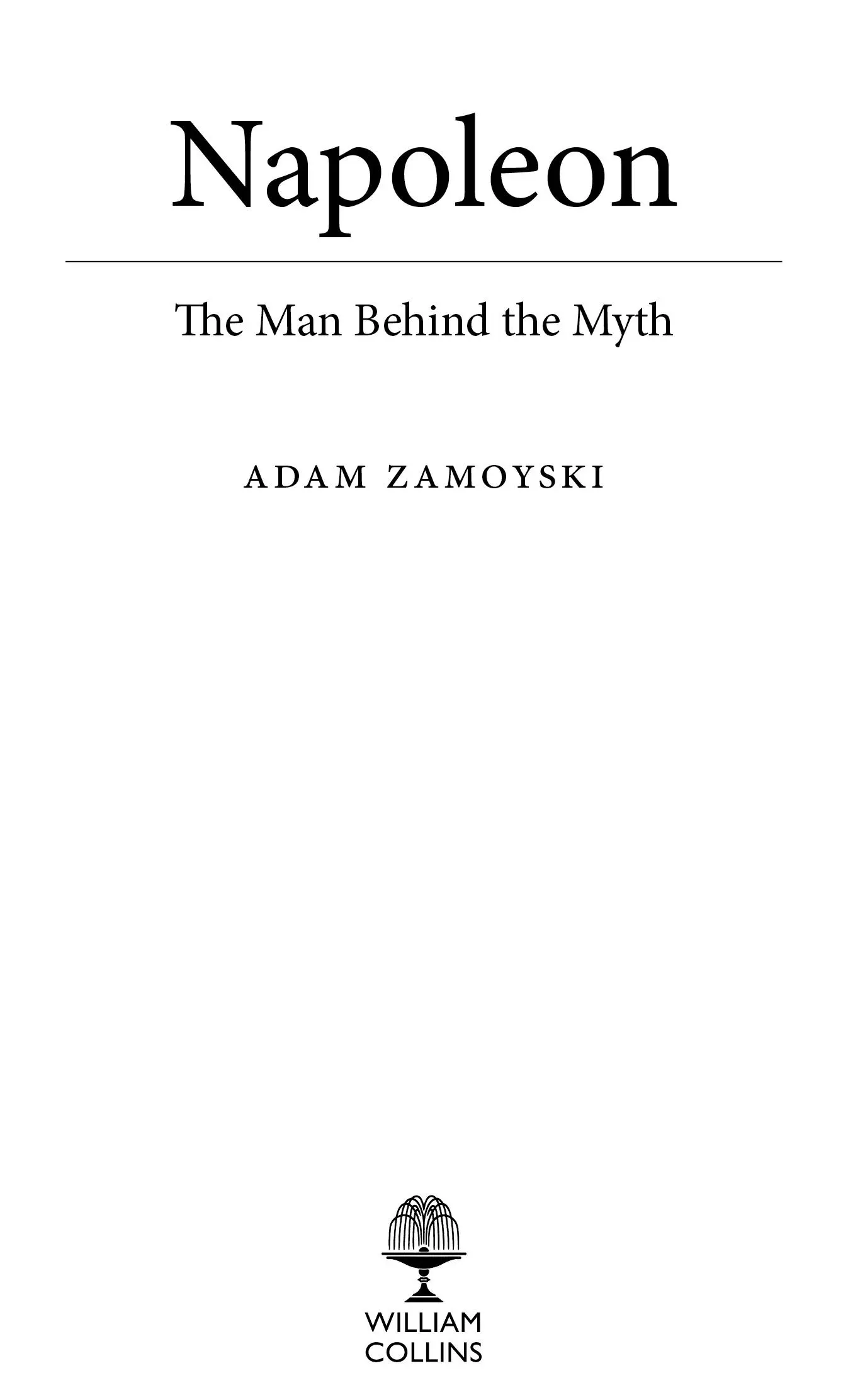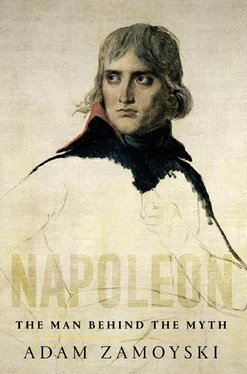
William Collins
An imprint of HarperCollins Publishers
1 London Bridge Street
London SE1 9GF
www.WilliamCollinsBooks.com
This eBook first published in Great Britain by William Collins in 2018
Copyright © Adam Zamoyski 2018
Cover photograph © Getty Images
Adam Zamoyski asserts the moral right to be identified as the author of this work
Maps by Martin Brown
A catalogue record for this book is available from the British Library
All rights reserved under International and Pan-American Copyright Conventions. By payment of the required fees, you have been granted the non-exclusive, non-transferable right to access and read the text of this e-book on-screen. No part of this text may be reproduced, transmitted, down-loaded, decompiled, reverse engineered, or stored in or introduced into any information storage and retrieval system, in any form or by any means, whether electronic or mechanical, now known or hereinafter invented, without the express written permission of HarperCollins.
Source ISBN: 9780008116071
Ebook Edition © October 2018 ISBN: 9780008116088
Version: 2018-08-28
In memory
of
GILLON AITKEN
Cover
Title Page
Copyright
Dedication
List of Illustrations
List of Maps
Family Tree
Map
Preface
1 A Reluctant Messiah
2 Insular Dreams
3 Boy Soldier
4 Freedom
5 Corsica
6 France or Corsica
7 The Jacobin
8 Adolescent Loves
9 General Vendémiaire
10 Italy
11 Lodi
12 Victory and Legend
13 Master of Italy
14 Eastern Promise
15 Egypt
16 Plague
17 The Saviour
18 Fog
19 The Consul
20 Consolidation
21 Marengo
22 Caesar
23 Peace
24 The Liberator of Europe
25 His Consular Majesty
26 Towards Empire
27 Napoleon I
28 Austerlitz
29 The Emperor of the West
30 Master of Europe
31 The Sun Emperor
32 The Emperor of the East
33 The Cost of Power
34 Apotheosis
35 Apogee
36 Blinding Power
37 The Rubicon
38 Nemesis
39 Hollow Victories
40 Last Chance
41 The Wounded Lion
42 Rejection
43 The Outlaw
44 A Crown of Thorns
Notes
Picture Section
Bibliography
Index
Also by Adam Zamoyski
About the Author
About the Publisher
Napoleon’s mother Letizia Bonaparte in 1800, by Jean-Baptiste Greuze. (Granger Historical Picture Archive/Alamy Stock Photo)
Two sketches of Bonaparte by Jacques-Louis David. (Sketches of Napoleon Bonaparte, 1797 (pencil), David, Jacques-Louis (1748–1825)/Musée d’Art et d’Histoire, Palais Massena, Nice, France/Bridgeman Images)
Bonaparte during the Italian campaign of 1796, by Giuseppe Longhi. (Paul Fearn/Alamy Stock Photo)
Bonaparte leading his troops across the bridge at Arcole, by Antoine-Jean Gros. (Photo by Universal History Archive/Getty Images)
Bonaparte in 1797, by Francesco Cossia. (Photo by Fine Art Images/Heritage Images/Getty Images)
Josephine Bonaparte in 1797, by Andrea Appiani. (ART Collection/Alamy Stock Photo)
Auguste Marmont, by Georges Rouget. (Wikimedia Commons)
Andoche Junot, by David. (© President and Fellows of Harvard College)
Joachim Murat. (ART Collection/Alamy Stock Photo)
Josephine’s son Eugène de Beauharnais, by Gros. (Hirarchivum Press/Alamy Stock Photo)
Napoleon’s younger sister Pauline, by Jean Jacques Thérésa de Lusse. (flickr/lost gallery/Pauline Bonaparte, Princess Borghese/De Lusse/CC by 2.0)
Bonaparte visiting plague victims at Jaffa during his Syrian campaign, by Gros. (Photo by Archiv Gerstenberg/ullstein bild via Getty Images)
Joseph Bonaparte. (Photo by Stefano Bianchetti/CORBIS/Corbis via Getty Images)
Jean-Baptiste Bernadotte, by Nicolas Joseph Jouy. (Heritage Image Partnership Ltd/Alamy Stock Photo)
Napoleon’s younger brother Lucien, by François-Xavier Fabre, c.1808. (ART Collection/Alamy Stock Photo)
Bonaparte in 1800, by Louis Léopold Boilly. (Napoleon Bonaparte (1769–1821) Premier Consul (oil on canvas), Boilly, Louis Léopold (1761–1845)/Private Collection/Archives Charmet/Bridgeman Images)
The house in the rue de la Victoire. (Photo 12/Alamy Stock Photo)
The Tuileries, c.1860. (Photo by LL/Roger Viollet/Getty Images)
Jean-Jacques-Régis Cambacérès, by Greuze, 1805. (Cambacérès/Photo © CCI/Bridgeman Images)
Charles-Maurice de Talleyrand in 1804, by David. (Photo Josse/Leemage/Corbis via Getty Images)
Joseph Fouché. (Portrait of Joseph Fouché (1759–1820) Duke of Otranto, 1813 (oil on canvas), French School, (19th century)/Château de Versailles, France/Bridgeman Images)
Josephine’s daughter Hortense de Beauharnais, by François Gérard. (Paul Fearn/Alamy Stock Photo)
The Château of Malmaison, by Henri Courvoisier-Voisin. (Photo Josse/Leemage/Corbis via Getty Images)
Napoleon’s younger brother Louis in 1809, by Charles Howard Hodges. (Photo by Fine Art Images/Heritage Images/Getty Images)
Napoleon crossing the Alps in 1802, by David. (Photo by GraphicaArtis/Getty Images)
The Emperor Napoleon I in 1805, by David. (Photo Josse/Leemage/Corbis via Getty Images)
A fragment of David’s painting of the coronation, showing Joseph, Louis, Napoleon’s three sisters, Hortense and her son Napoléon-Charles. (Photo Josse/Leemage/Corbis via Getty Images)
Napoleon’s youngest brother Jérôme, 1805. (Courtesy of the Maryland Historical Society, xx.5.52)
Napoleon at Eylau, by Gros (Photo by Universal History Archive/Getty Images)
Marshal Jean Lannes, by Gérard. (Photo by Fine Art Images/Heritage Images/Getty Images)
General Armand de Caulaincourt, sketched in 1805 by David. (Portrait of Armand Augustin Louis. Marquis de Caulaincourt (1772–1827) (pencil on paper) (b/w photo), David, Jacques Louis (1748–1825)/Musée des Beaux-Arts, Besancon, France/Bridgeman Images)
General Géraud-Christophe Duroc, by Anne-Louis Girodet-Trioson. (Portrait of Duroc, Grand Marshal of the Palace (oil on canvas), Girodet de Roucy-Trioson, Anne Louis (1767–1824)/Musée Bonnat, Bayonne, France/Bridgeman Images)
Napoleon I in 1806, by Jean-Auguste-Dominique Ingres. (Photo Josse/Leemage/Corbis via Getty Images)
View of the proposed palace for the King of Rome, by Pierre-François Fontaine. (From Projets d’architecture, plan number 32, France, 19th century/De Agostini Picture Library/Bridgeman Images)
Napoleon en famille , by Alexandre Menjaud. (Napoleon I (1769–1821), Marie Louise (1791–1847) and the King of Rome (1811–73) 1812 (oil on canvas), Menjaud, Alexandre (1773–1832)/Château de Versailles, France/Bridgeman Images)
Napoleon in early 1812, by David. (Photo by Ann Ronan Pictures/Print Collector/Getty Images)
Napoleon on the bridge of HMS Bellerophon , by Charles Lock Eastlake, 1815. (Granger Historical Picture Archive/Alamy Stock Photo)
Читать дальше













